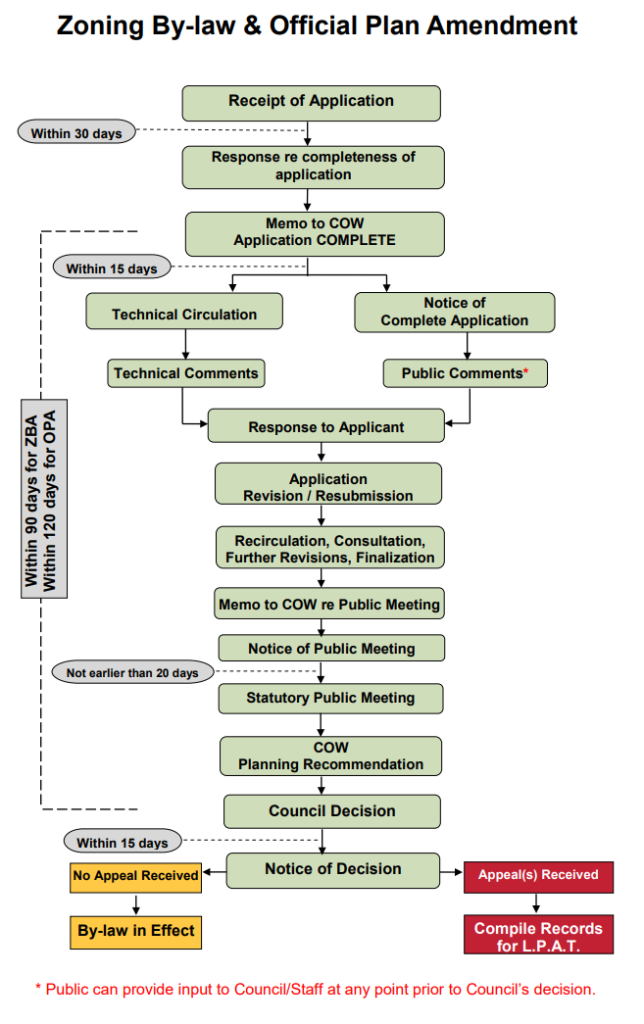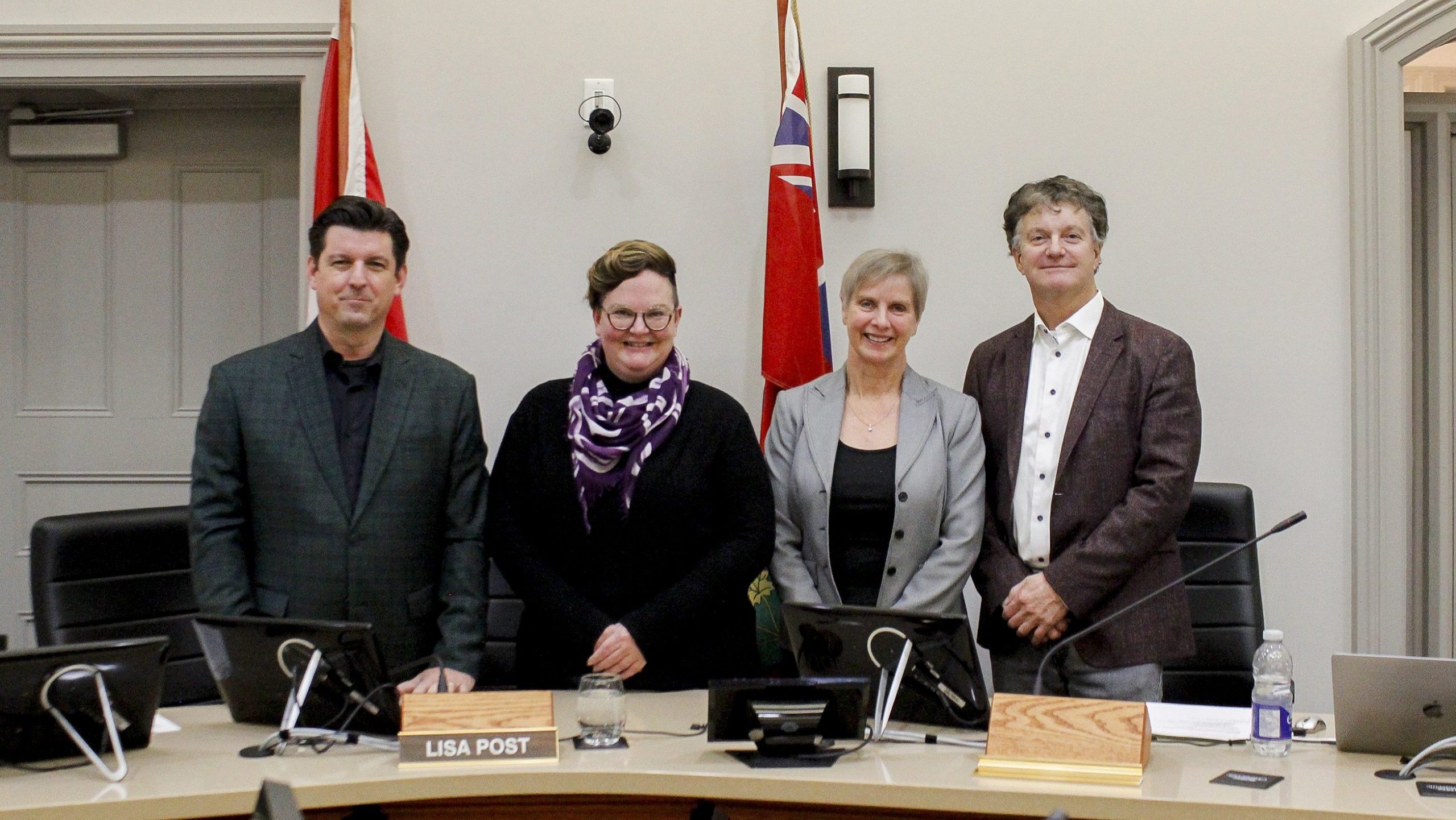An Official Plan is long-term planning blueprint that guides how all land within a municipality can be used and developed over the next 20 to 30 years.
It sets out the vision, principles, goals, objectives and policies to direct the growth, physical change, and design of the municipality as a whole.
It also sets standards for the review and approval of future development applications to balance the interests of:
- Developers and neighborhood residents
- Province, municipality and the community
- Social, economic and built and natural environments impacts
Everything a municipality does related to land use must follow the Official Plan, including:
- Local council and municipal officials
- New services such as sewer or watermains
- Prerequisite for community improvement plans
- Provides a basis for the Zoning Bylaw and related bylaws
- Provisions relating to the use of the holding symbol
What is an Official Plan?
In general, Official Plans have 3 parts:
- Policies that describe specific uses that are allowed in each designation, and criteria for evaluating specific types of applications or developments (new plans of subdivision, for example)
- Schedules (or maps) of all lands in the municipality, with colours or patterns used to represent each land use designation
- Appendices which provide further information, add clarification and are contained in the document for ease of reference
They must contain:
(a) goals, objectives and policies established primarily to manage and direct physical change and the effects on the social, economic, built and natural environment of the municipality or part of it, or an area that is without municipal organization;
(a.1) such policies and measures as are practicable to ensure the adequate provision of affordable housing;
(b) a description of the measures and procedures for informing and obtaining the views of the public in respect of,
(i) proposed amendments to the official plan or proposed revisions of the plan,
(ii) proposed zoning by-laws,
(iii) proposed plans of subdivision, and
(iv) proposed consents under section 53; and
(c) such other matters as may be prescribed. 2015, c. 26, s. 17; 2017, c. 23, Sched. 3, s. 5 (1).
Same
(2) An official plan may contain,
(a) a description of the measures and procedures proposed to attain the objectives of the plan;
(b) a description of the measures and procedures for informing and obtaining the views of the public in respect of planning matters not mentioned in clause (1) (b); and
(c) such other matters as may be prescribed. 2015, c. 26, s. 17.
Section 16 of the Planning Act
Goals
The purpose of an Official Plan is to describe what kind of community a municipality wants to become in the future, including:
- Ensuring the adequate provision of affordable housing
- Promoting orderly growth and compatibility among land uses
- Ensuring that growth meets the long term needs of the community
- Informing the public of the municipality’s general land use approach over both the short and long term
- Reflecting the collective aspirations of residents and business owners
- Identifying how health and safety, the environment, and cultural heritage should be protected
- Guiding the expansion of new services like sewers, water pipes and roads
Uses (zoning)
The Official Plan decides where new houses, shops, factories, schools, parks and other places will be built, including:
- Residential
- Commercial
- Industrial
- Agricultural
- Parks and open space
- Transportation and infrastructure
Developments
The Official Plan provides guidance on:
- Growth direction – inward and upward (intensification/infill) vs outward (suburban sprawl)
- Location – where new housing, industry, offices and shops can be located
- Timing – in what order will areas develop over the short and long term
- Infrastructure – what roads, transit, watermains, sewers, parks, garbage dumps, and schools will be needed
- Climate change – addressing, mitigating and adapting
Plan must allow for affordable housing units
Inclusionary zoning policies
(4) An official plan of a municipality that is prescribed for the purpose of this subsection shall contain policies that authorize inclusionary zoning by,
(a) authorizing the inclusion of affordable housing units within buildings or projects containing other residential units; and
(b) providing for the affordable housing units to be maintained as affordable housing units over time. 2016, c. 25, Sched. 4, s. 1 (2).
How is an Official Plan created?
When considering an official plan, your local council or planning board must ensure that:
- at least one public meeting is held, notice of which must be given at least 20 days ahead of time, usually through local newspapers or by mail
- the approval authority is consulted and given the opportunity to review all supporting information and material
- for the statutory official plan update, a special meeting of council that is open to the public, as well as an open house information session and at least one public meeting are held
- adequate information, including a copy of the proposed plan, is made available to the public in advance of the public meeting
Any person or public body may provide written comments and/or speak at the public meeting about the proposed plan.
Your municipal council must engage with Indigenous communities and may consult with agencies, boards, authorities or commissions before making a decision.
Plan must be updated at least every 5 years
Municipalities must revise a new Official Plan within 10 years after it is created, and every 5 years after an update done through an amendment to the plan to ensure it aligns with current provincial legislation, municipal strategic plan and policies, and community priorities:
The council shall revise the plan no less frequently than,
Section 26 (1.1) of the Planning Act
- (a) 10 years after it comes into effect as a new official plan; and
- (b) every five years thereafter, unless the plan has been replaced by another new official plan.
Updating official plan
26 (1) If an official plan is in effect in a municipality, the council of the municipality that adopted the official plan shall, in accordance with subsection (1.1), revise the official plan as required to ensure that it,
(a) conforms with provincial plans or does not conflict with them, as the case may be;
(b) has regard to the matters of provincial interest listed in section 2; and
(c) is consistent with policy statements issued under subsection 3 (1). 2015, c. 26, s. 24 (1).
Plan must conform to Provincial Planning Statement
The Official Plan must conform, or not conflict, with the policies in the latest Provincial Planning Statement (PPS), which contains the province’s priorities relating to land use planning and development.
Plans exempt from provincial approval
The Minister of the Ministry of Municipal Affairs and Housing may exempt an official plan and all or some of its proposed amendments from the requirement for provincial approval.
- Council initiates an official plan amendment
- Proposed Official Plan amendment is prepared. Following this, notice and information is provided to the public and the approval authority is consulted. Other agencies may also be consulted
- Public meeting is held
- Council adopts the official plan amendment
- Council issues notice of adoption to the public
- Appeals by person or public body to the Ontario Land Tribunal (OLT). Those who made a verbal presentation at the public meeting or made a written submission to council before a decision was made, may appeal the council’s decision to adopt to the OLT within the 20-day appeal period. The OLT is an independent administrative tribunal responsible for hearing appeals and deciding on a variety of contentious municipal matters (See section 6, the Ontario Land Tribunal).
- The OLT may dismiss the appeal without holding a hearing or will hold a hearing and make a final decision except when a provincial interest is declared.
- If there is no appeal, the official plan and/or amendment comes into effect on the day after the appeal period expires.
Plans not exempt from provincial approval
After council adopts an official plan, it is submitted to the appropriate approval authority to review and make a decision.
- Council initiates an Official Plan amendment
- Proposed Official Plan amendment is prepared. Following this, notice and information is provided to the public and the approval authority is consulted. Other agencies may also be consulted
- If the amendment is an official plan update under Section 26 of the Planning Act such as a mandatory Official Plan review, an open house must be held prior to council holding a public meeting. This step is not required for all other official plan amendments
- Public meeting is held
- Council adopts the official plan amendment
- Council issues notice of adoption to the public and sends the official plan amendment to the approval authority
- Approval authority may consult (as needed), makes a decision on the official plan amendment, and gives notice of its decision. The official plan amendment comes into effect if there are no appeals within the 20-day appeal period.
- Appeal(s) to the OLT. With some restrictions, any qualifying person or public body may appeal the approval authority’s decision to the OLT. However, where the minister is the approval authority (for matters under section 26 of the Planning Act), there is no ability to appeal the minister’s decision on an official plan update.
- OLT may dismiss the appeal without holding a hearing or will hold a hearing and make a final decision except when a provincial interest is declared.
Municipality must consult the public by holding a special meeting
Official Plans must be prepared with input from your community, considering a broad range of interests and perspectives and reflecting a community vision for future change:
Before revising the official plan under subsection (1), the council shall,
(a) consult with the approval authority and with the prescribed public bodies with respect to the revisions that may be required; and
(b) hold a special meeting of council, open to the public, to discuss the revisions that may be required. 2006, c. 23, s. 13.
Section 26 (3) of the Planning Act
How to appeal an Official Plan update
To be able to appeal an Official Plan update to the Ontario Land Tribunal, you are required to have first provided your feedback in the form of a verbal presentation at a public meeting or in a written submissions to council during the review process (ie. before the amendment is approved by council).
If you have any concerns about the Official Plan, let the members of council know about them early in the process. Council will then have time to think about what you said and may make changes before the plan is adopted.
How is an Official Plan changed? (Official Plan Amendments)
An official plan can be changed or amended. Changes (or “amendments”) to the maps and/or policies in the Official Plan must go through the amendment process outlined in the Ontario Planning Act.
The Official Plan may need to be changed because of changes in provincial policies, municipal policies, or at the request of a developer if specific policies or constraints on their property does not allow a property owner to proceed with a particular proposed development project.
If you want to use, alter or develop your property or develop it in a way that conflicts with the municipal official plan, an amendment to the plan is required and you must apply for a site-specific Official Plan Amendment in an Official Plan Amendment application:
Official Plan amendment application process
Planning Advisory Committees are responsible for reviewing Official Plan amendment applications.
In Kingston, changing the Official Plan involves 10 steps:
City of Kingston
- Pre-consultation meeting – talk to planning staff: Submit a pre-application to see if you need an Official Plan change and what drawings and reports you will need to include with your application. You must submit your pre-application through DASH.
- Submit your application and pay fee: Include all required drawings and reports and pay the required application fee. You must submit your application through DASH.
- Application review: A planner reviews your application for completeness, and issues a public notice indicating that the city has received an application for a change to the Official Plan. The planner will also circulate the application to relevant City departments and external groups for review. The planner will provide you with a list of all comments received.
- Recommendation report: Once the application review is complete and all comments provided by the planner have been addressed, the planner prepares a report to the Planning Committee summarizing your proposal, and an analysis of the relevant policies. The report also includes a recommendation to approve the application as-is, with changes, or deny it.
- Tell the public about the meeting: The planner sets up a public meeting at the Planning Committee. Public meeting notices are sent by mail, posted on-site, and may appear on our website or in the newspaper..
- Public meeting: At the meeting, you or your agent present the proposed development, staff may offer information and Committee members may ask questions. Members of the public may also ask questions and provide feedback.
- Planning Committee recommendation to Council: At the meeting, the Planning Committee discusses the application and makes recommendations to our Council.
- Council meeting: Council reviews the Planning Committee’s recommendation. They may decide to approve the application, deny it, or ask for more information.
- Advertise council decision and appeal period: After the Council meeting, a notice of Council’s decision will be sent out and will include the deadline for any appeals to be submitted.
- Final say and Bylaw passed: If no one appeals, the change to the Official Plan comes into effect. If someone appeals, your application will go to the Ontario Land Tribunal for a decision.
Here is Port Hope’s flow chart of the application process:

Quinte West tracks Official Plan Amendment applications:

When assessing an amendment application, council will consider:
- The rationale or basis for the change
- The direction provided by the Provincial Policy Statement
- The goals and objectives of the Official Plan
- Conformity to the Official Plan
- The desirability and appropriateness of changing the Plan
- The impacts the proposed change will have on the character of the area
How to appeal an Official Plan amendment
To be able to appeal an Official Plan amendment to the Ontario Land Tribunal, you are required to have first provided your feedback in the form of a verbal presentation at a public meeting or in a written submissions to council during the review process (ie. before the amendment is approved by council).
If you have any concerns about the Official Plan, let the members of council know about them early in the process. Council will then have time to think about what you said and may make changes before the plan is adopted.
Difference between Official Plan and Zoning By-Law
The Official Plan provides a the general policies, principles and vision for future land use.
Zoning Bylaws put the policies in the Official Plan into effect by outlining specific requirements that support these policies and are legally enforceable such as:
- Land use type (eg. residential, commercial, industrial)
- Location zoning maps (urban, rural)
- Minimum lot size
- Maximum building height
- Minimum number of parking spaces
When an Official Plan policy is changed, new Zoning Bylaws must be created to apply the change.
Both the Official Plan and Zoning Bylaws can be changed by the municipality or through an application process started by an individual or developer. Amendment applications may have to amend the Zoning By-law and the Official Plan at the same time in a combined application. If submitted at the same time for the same property they are reviewed together.
Fees to change Official Plan
- Belleville – $6,550 to $8,740
- Caledon
- $21,218 for pre-consultation submission/review, plus
- $15,913.50 for Official Plan Amendment Application
- Guelph
- $15,900 to $24,600 for Minor OPA – with Pre-Submission Review
- Hamilton
- $44,390 to $234,925
- London
- $16,020
- Mississauga
- $27,865
- Toronto – $129,443.68
- Quinte West – $4,173
- Hastings County – $1,000
- York Region – $9,300 to $26,477.39
How to request an Official Plan amendment?
Contact the municipality’s planning department to inquire about their process.
The Citizen’s Guide to Land Use Planning was developed by the Government of Ontario to provide property owners with helpful information about the legislation surrounding land use planning.
Municipal Official Plan examples
London
It emphasizes:
- growing inward and upward to reduce the costs of growth
- creating walkable communities
- revitalizing urban neighbourhoods and business areas
- protecting farmlands
- reducing greenhouse gases and energy consumption
Take action
You can take part in planning the future of your community by:
- Planning Advisory Committees are responsible for reviewing Official Plan amendment applications.
- Reading a proposed Official Plan to learn how it will affect you, your property and your community
- Attending information sessions, including open houses and public meetings to discuss the plan
- Attending public meetings or making written submissions to council to provide your feedback and opinions, one of which you must do in order to qualify for the right to appeal
- Correspond with council and municipal staff to resolve your concerns



Comments
We want to hear from you! Share your opinions below and remember to keep it respectful. Please read our Community Guidelines before participating.